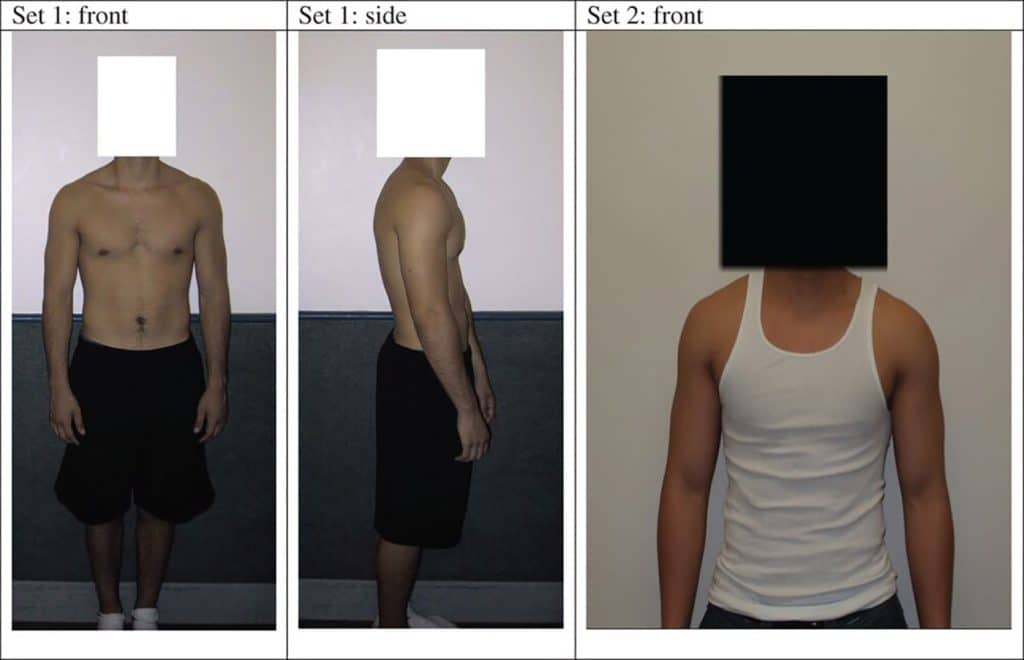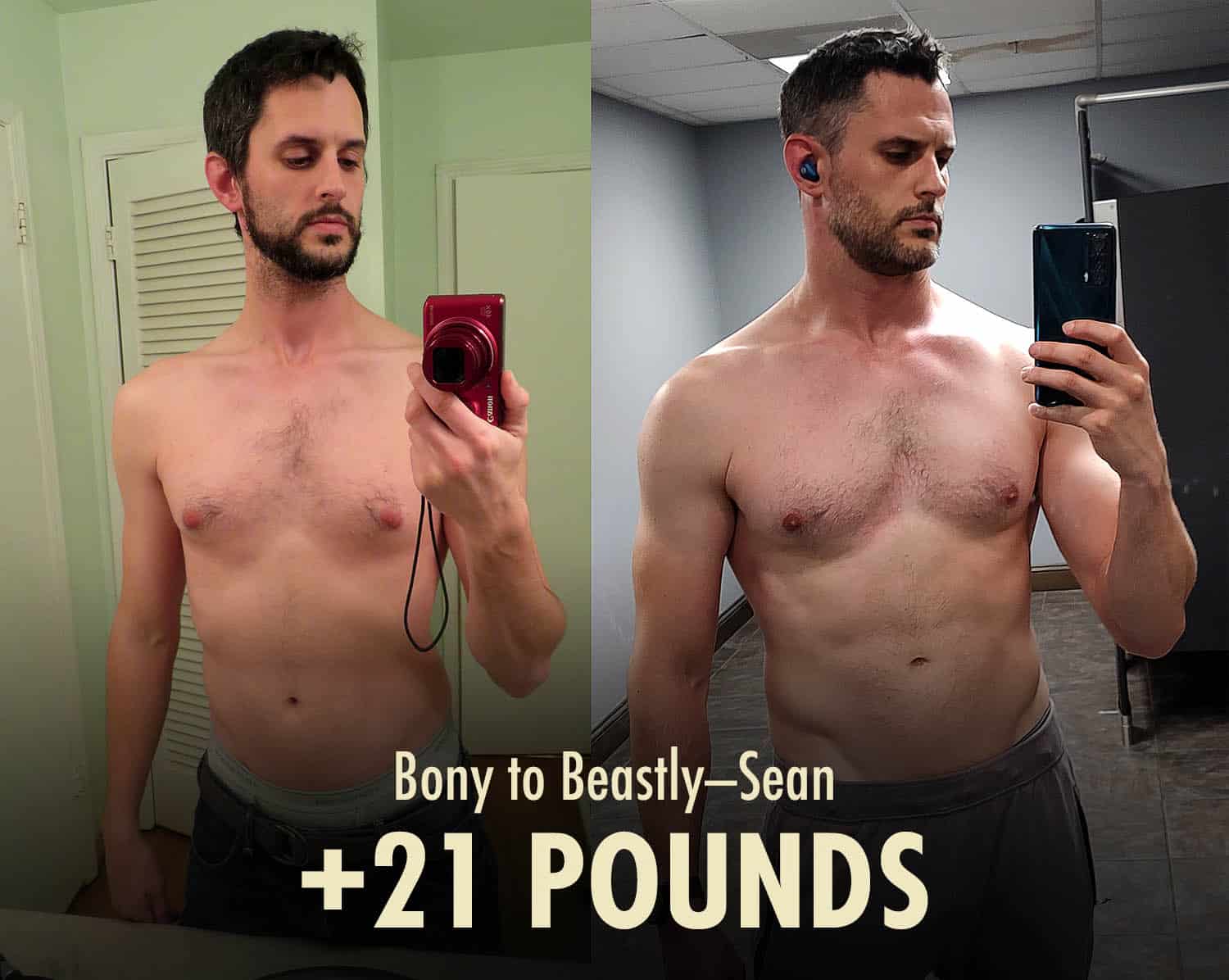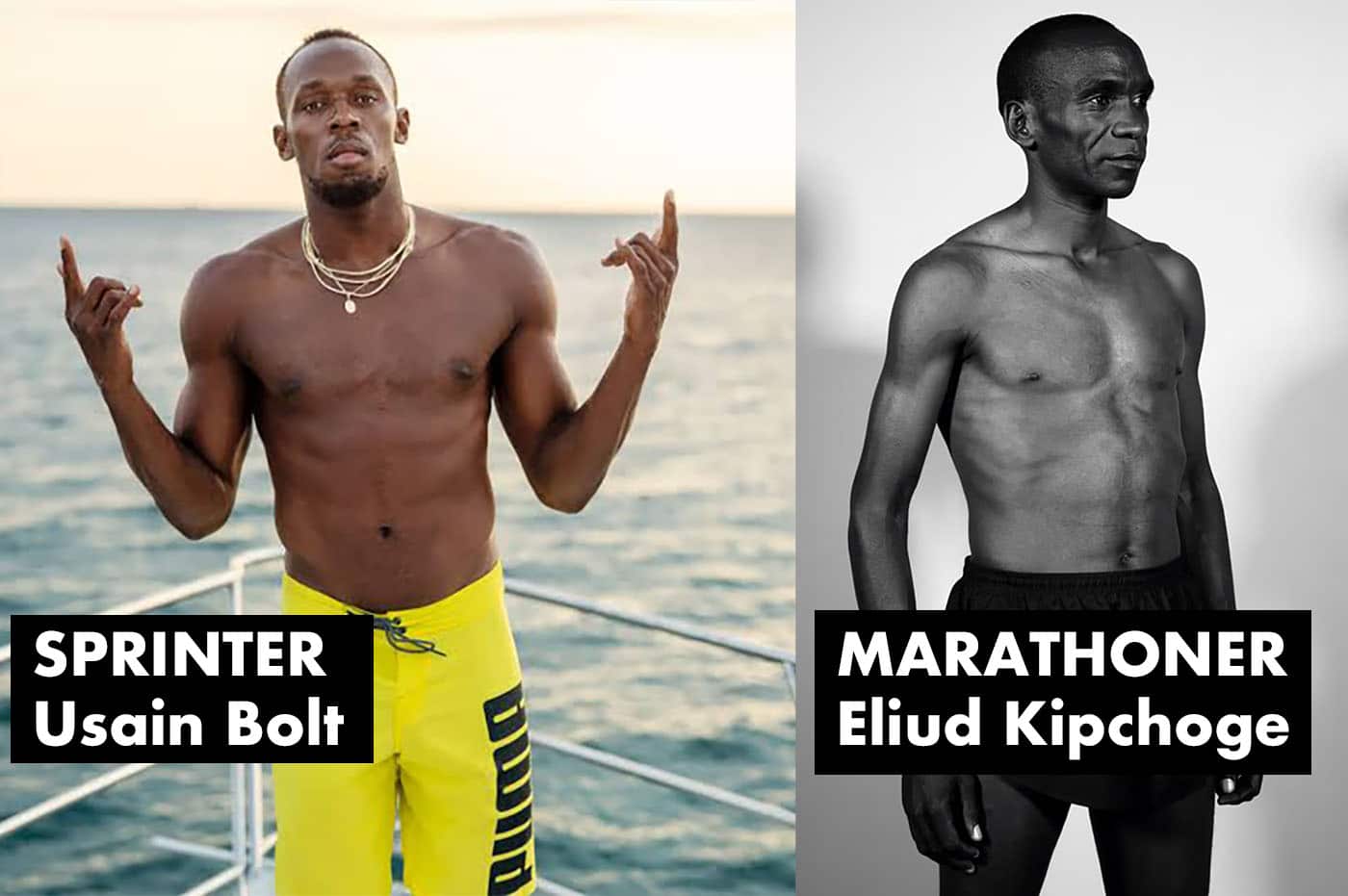
How Muscular Should You Get? Ideal Male Body Weight & FFMI
I want to give you an idea about what body weight you should aim for. You’ll know exactly how much more muscle you should build, and exactly how much fat you should lose. You also know how heavy you should get when bulking, and how light you should get when cutting.
We’ll cover it from a few angles, going over the ideal BMI for your health, the amount of muscle women find most attractive, what men think looks the best, and also what’s best for different performance goals.

The Healthiest Male BMI
For a long time, the healthiest weight was thought to be a “normal” BMI of 18.5 to 25. The idea is that if your BMI is less than 18.5, you have too little muscle, and if your BMI is above 25, you have too much fat.
Here’s what that looks like:

On the left, I’m 6’2 and 130 pounds, giving me an underweight BMI of 17. On the right, I’m bulked up to 205 pounds, giving me an overweight BMI of 26. BMI isn’t a very good way to figure out how healthy you are, though, and there are two situations where it can be especially misleading:
- The Skinny-Fat Problem: First, if someone is skinny fat, with skinny limbs and a barrel belly, they might be both undermuscled AND too fat, both of which come together to give them a healthy BMI, even though they aren’t healthy.
- The Bodybuilder Problem: If you’re carrying a lot of muscle mass, you might pop off the top side of the range. That’s what happened to me. This is where BMI gets tricky.
Even naturally skinny guys like me can build enough muscle to pop off the top side of the BMI range. Many athletes are in great health while being technically overweight. Most men prefer the look of guys who look strong and overweight (full article).
The scientific consensus has slowly been shifting. The largest and most recent meta-analysis looked at 5.8 million people, and they found that people with a BMI of 23–27 tended to be the healthiest and live the longest. You’d aim for the lower end if you’re an endurance athlete. You’d aim for the upper limit if you want to be bigger, stronger, and better looking.
Here’s a chart so you can get an idea of your ideal BMI:
| Height | BMI 23 | BMI 27 |
|---|---|---|
| 5’1″ / 155 cm | 122 lb / 55 kg | 143 lb / 65 kg |
| 5’2″ / 157 cm | 126 lb / 57 kg | 148 lb / 67 kg |
| 5’3″ / 160 cm | 130 lb / 59 kg | 152 lb / 69 kg |
| 5’4″ / 163 cm | 134 lb / 61 kg | 157 lb / 71 kg |
| 5’5″ / 165 cm | 138 lb / 63 kg | 162 lb / 74 kg |
| 5’6″ / 168 cm | 143 lb / 65 kg | 168 lb / 76 kg |
| 5’7″ / 170 cm | 147 lb / 67 kg | 173 lb / 79 kg |
| 5’8″ / 173 cm | 152 lb / 69 kg | 178 lb / 81 kg |
| 5’9″ / 175 cm | 157 lb / 71 kg | 183 lb / 83 kg |
| 5’10” / 178 cm | 162 lb / 73 kg | 189 lb / 86 kg |
| 5’11” / 180 cm | 167 lb / 76 kg | 194 lb / 88 kg |
| 6’0″ / 183 cm | 172 lb / 78 kg | 200 lb / 91 kg |
| 6’1″ / 185 cm | 177 lb / 80 kg | 206 lb / 93 kg |
| 6’2″ / 188 cm | 182 lb / 83 kg | 212 lb / 96 kg |
| 6’3″ / 191 cm | 187 lb / 85 kg | 218 lb / 99 kg |
| 6’4″ / 193 cm | 193 lb / 88 kg | 224 lb / 102 kg |
| 6’5″ / 196 cm | 198 lb / 90 kg | 231 lb / 105 kg |
| 6’6″ / 198 cm | 204 lb / 93 kg | 237 lb / 108 kg |
| 6’7″ / 201 cm | 209 lb / 95 kg | 243 lb / 110 kg |
| 6’8″ / 203 cm | 215 lb / 98 kg | 250 lb / 113 kg |
| 6’9″ / 206 cm | 221 lb / 100 kg | 257 lb / 117 kg |
Is Gaining Too Much Muscle Unhealthy?
The main study looking at muscularity and health is this one. The researchers looked at Fat-Free Mass Index (FFMI), which measures how much lean mass you have relative to your height. They found that gaining muscle improves your health up until a Fat-Free Mass Index of about 20.
You can calculate your own FFMI using this calculator. Or, if you want a quick idea of what that looks like, here’s a photo of me when I had an FFMI of 20:

After you get to an FFMI of 20, the health benefits plateau. Gaining more muscle isn’t any better for you, but it also isn’t any worse. The researchers couldn’t find a point where gaining extra muscle became unhealthy.
The catch is that you need to build that muscle in a healthy way. If you’re bulking up on unhealthy food, gaining excessive amounts of fat, or abusing PEDs, then that can absolutely harm your health. The muscle wouldn’t be the problem, though.
There’s probably a point where gaining more muscle starts to be unhealthy, but I’m not sure it’s possible for the average person to get there naturally, especially if they have relatively normal muscle-building genetics. If you wanted to play it safe, though, then you could cap your overall BMI at 27.
The Most Attractive Body Weight
A 2012 study had men and women choose the most attractive male body weight. Women preferred guys with a BMI of 24.5, whereas men preferred the look of guys with a BMI of 26. (I should also note that gay men, being men, tend to prefer big muscles.)
Those findings haven’t replicated perfectly. In 2017, Dr. Aaron Sell published a study where women ranked photos of male physiques. The women preferred the more muscular guys, with no upper limit. They also preferred the leaner guys, but the effect wasn’t nearly as big. The most important part of being attractive is being strong and capable.

I spoke with Dr. Sell, asking exactly how muscular the most muscular guys were. He told me that these were college men, and some of them were quite athletic and strong, but none of them looked unnaturally large. Some of them had BMIs higher than 24.5, but none of them were big juiced-up bodybuilders.
I surveyed a thousand people (both male and female), asking them which physiques they preferred. The vast majority preferred Brad Pitt’s Fight Club physique:

Quite a few of the men preferred that image of Frank Zane on the far right, which women ranked as the lowest of all the physiques. My interpretation was that women prefer men who look strong, lean, and athletic in a natural and healthy way. Frank Zane looks like a juiced-up bodybuilder, so the vanity and drug abuse ruin the impressiveness of his physique.
I used a few different spreads to confirm the findings. Here’s another one:

In this case, a Silver Era natural bodybuilder won. He looks athletic and strong, but also fairly normal. He doesn’t have exceptional genetics, and you wouldn’t expect him to win a local natural bodybuilding competition. He’s got a physique that all of us could build with a few years of working out three times per week.
In second place, there was another Silver Era natural bodybuilder with a more impressive physique. I think he looks cooler. That’s the sort of physique I’d like for myself. But he’s an example of a guy becoming more muscular than women prefer… at least when he’s flexing his muscles with a pump at the beach. It could be that in normal circumstances, his physique looks less extreme, thus making it look better to women.
Some people complained that the women might be judging the bodies by their other traits, not just the amount of muscle. Maybe they recognized Brad Pitt from the first spread (which makes sense) or the Silver Era natural bodybuilder who won the second line-up (doubtful).
So, I drew a bunch of male physiques and ran a new survey (on a few hundred new women). Most women preferred about the same level of muscularity:

These are illustrations, so I wouldn’t read too much into the specifics. I’d go more based on the feeling. I think what’s happening is that women want a guy who gives off the impression of being strong, healthy, and athletic in a natural and healthy way. They don’t want a guy who abuses drugs or obsesses over his appearance.

So think of a transformation like this one, from Sean. He built muscle doing a couple of our programs, got way stronger, and transformed his appearance in a way that made him look healthier and more athletic. That’s the most attractive kind of physique. That’s the kind of transformation women are drawn to.
Bodybuilding Aesthetics
In all of the research I’ve seen, and in all the surveys I’ve conducted, men have wanted to be a fair bit bigger than women prefer. I’m one of those guys, and I don’t really see any problem with it. It’s cool to get big and strong, and it’s good for us, and women don’t mind, so why not?
If you build muscle in a healthy way, and if you don’t seem obsessive or narcissistic about it, then most women won’t really care if you build a bunch of extra muscle. You almost never hear of guys getting so muscular that their wives or girlfriends take issue with it (as long as the methods they’re using are reasonable and healthy).
I tested this idea by asking women which physiques they prefer the most, AND which physiques they find attractive. They tend to find the more athletic-looking guys most attractive, but they’re still attracted to the natural bodybuilder look.
My wife is one of those women who rate athletic bodies as more attractive, and she says I look best at around 185 pounds, but she’s just as happy when I’m up at 205 pounds. 205 pounds still looks healthy and natural, and being stronger is good, so there’s no problem at all.
As for what men prefer, it seems that once guys start lifting, then being bigger and stronger tends to be better. Just like if you start running, then being able to run faster and further is better. Once you’re in the hobby, getting better at the hobby is better. Ask a soccer fan who has the best body, and he’ll probably tell you Cristiano Ronaldo.
The Ideal Male FFMI
FFMI is a good way to measure how muscular we are relative to our height. That lets us compare our physiques against each other. You can calculate your FFMI here, and then aim for these milestones:
- Less than 18: Below average muscle mass. Bulking up to an FFMI of 20 will improve your health and appearance by quite a lot.
- 18–20: Average muscle mass. This can look great if you’re lean and healthy. Many athletes have an FFMI within this range. So do some of the most attractive men in the world.
- 20–22: Above average muscle mass. This is when you start to “look like you lift.” You start to look more like a bodybuilder or American football player than a generic athlete. You might gain some extra points with women.
- 22–25: Highly muscular. This is when you start to look like a serious bodybuilder with great genetics. You can win natural bodybuilding shows. You’ll be one of the biggest and strongest guys you know. Men will compliment you. Women still love it, but they would have liked you just as much if you had stayed smaller.
- More than 25: Suspiciously muscular. This is when muscle mass starts to look suspect to women, especially if it looks like you’re obsessive or abusing steroids. You’re “muscle-bound” instead of muscular. You’re “bulky” instead of strong. Some men think it looks cool. Some think it looks stupid. It’s a polarizing physique, especially if you give off the impression of being vain, having body image issues, or not being natural.
That means that, all things considered, the idea FFMI for most men is probably in the neighbourhood of 20–24, which represents being lean and athletic all the way up to being an impressively strong natural bodybuilder.
Performance
The final thing to consider is performance. Generally, the bigger and heavier you get, the stronger you’ll get, but the more weight you’ll need to carry, so the harder it is to carry your body over great distances. That’s why sprinters are half the size of bodybuilders, and marathon runners are half the size of sprinters:

You can get a good idea of how this plays out by looking at the top athletes in most sports:
- Soccer players need to be fast, but they don’t get much rest, so it pays to be lighter. They’re bigger than marathoners but smaller than sprinters.
- American Football quarterbacks, running backs, and wide receivers need to be fast but also strong, so they carry a little more muscle than sprinters. They’re often about my size, in the neighbourhood of 6’2 and 210. But the linemen rely more on brute strength, so they’re enormous, often up near 300 pounds.
- Sumo wrestlers rely even more on size, strength, and momentum, with some of them reaching 450 pounds, with more lean mass than any other type of athlete (including strongmen, powerlifters, and bodybuilders).
That means there’s a cost to getting as big as you possibly can, and I think that’s a good thing. It means that if we strive for a mix of size, strength, speed, and stamina, then we wind up at the healthiest bodyweight, with a physique that’s maximally attractive to women, able to pursue as much excellence as we want.
In my case, I want to be able to bench 315 pounds (which I can already do), deadlift 500 (my best is 485), and run a marathon in under 4 hours (which is coming along slowly). And I want to be able to do that with great health markers, no chronic injuries, and without spending more than about an hour per day on exercise. If I can do all of that while weighing less than 200 pounds, I’d be stoked.
Alright, that’s it for now.
If you want help with any of this, I’m happy to answer comments. I can also guide you through the whole process of getting bigger, stronger, leaner, and healthier. If you want my help, we have a foundational muscle-building program and a more advanced health and aesthetics program. Both include online coaching.
Shane Duquette is the founder of Outlift, Bony to Beastly, and Bony to Bombshell, each with millions of readers. He's a Certified Conditioning Coach (CCC), has gained 70 pounds, and has over a decade of experience helping more than 15,000 people build muscle. He also has a degree in fine arts, but those are inversely correlated with muscle growth.
